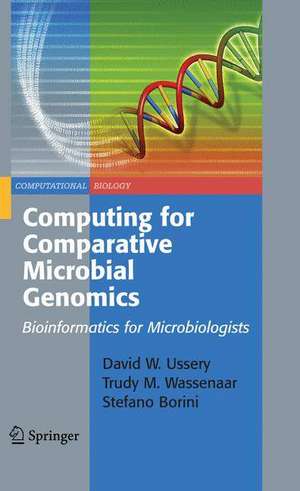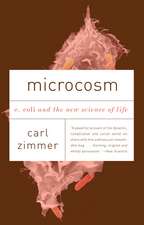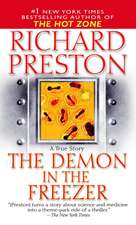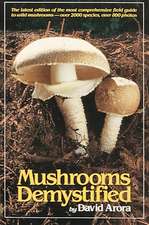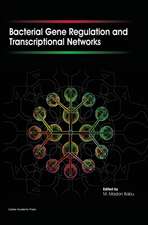Computing for Comparative Microbial Genomics: Bioinformatics for Microbiologists: Computational Biology, cartea 8
Autor David Wayne Ussery, Trudy M. Wassenaar, Stefano Borinien Limba Engleză Hardback – 26 feb 2009
| Toate formatele și edițiile | Preț | Express |
|---|---|---|
| Paperback (1) | 387.75 lei 6-8 săpt. | |
| SPRINGER LONDON – 22 oct 2010 | 387.75 lei 6-8 săpt. | |
| Hardback (1) | 394.51 lei 6-8 săpt. | |
| SPRINGER LONDON – 26 feb 2009 | 394.51 lei 6-8 săpt. |
Din seria Computational Biology
- 20%
 Preț: 539.14 lei
Preț: 539.14 lei - 15%
 Preț: 645.60 lei
Preț: 645.60 lei - 15%
 Preț: 633.68 lei
Preț: 633.68 lei - 20%
 Preț: 637.06 lei
Preț: 637.06 lei - 5%
 Preț: 1434.18 lei
Preț: 1434.18 lei - 18%
 Preț: 945.79 lei
Preț: 945.79 lei -
 Preț: 322.31 lei
Preț: 322.31 lei - 18%
 Preț: 945.13 lei
Preț: 945.13 lei - 15%
 Preț: 644.95 lei
Preț: 644.95 lei -
 Preț: 447.56 lei
Preț: 447.56 lei - 15%
 Preț: 643.65 lei
Preț: 643.65 lei - 15%
 Preț: 648.89 lei
Preț: 648.89 lei - 18%
 Preț: 900.80 lei
Preț: 900.80 lei - 15%
 Preț: 653.14 lei
Preț: 653.14 lei -
 Preț: 400.85 lei
Preț: 400.85 lei - 15%
 Preț: 696.50 lei
Preț: 696.50 lei -
 Preț: 387.96 lei
Preț: 387.96 lei - 15%
 Preț: 645.79 lei
Preț: 645.79 lei - 20%
 Preț: 560.67 lei
Preț: 560.67 lei - 15%
 Preț: 653.65 lei
Preț: 653.65 lei - 15%
 Preț: 638.57 lei
Preț: 638.57 lei - 20%
 Preț: 575.99 lei
Preț: 575.99 lei - 18%
 Preț: 1112.15 lei
Preț: 1112.15 lei - 18%
 Preț: 785.42 lei
Preț: 785.42 lei - 20%
 Preț: 1047.22 lei
Preț: 1047.22 lei - 18%
 Preț: 1230.84 lei
Preț: 1230.84 lei
Preț: 394.51 lei
Nou
Puncte Express: 592
Preț estimativ în valută:
75.50€ • 78.37$ • 62.95£
75.50€ • 78.37$ • 62.95£
Carte tipărită la comandă
Livrare economică 25 martie-08 aprilie
Preluare comenzi: 021 569.72.76
Specificații
ISBN-13: 9781848002548
ISBN-10: 1848002548
Pagini: 288
Ilustrații: XIV, 270 p. With online files/update.
Dimensiuni: 155 x 235 x 21 mm
Greutate: 0.57 kg
Ediția:2009
Editura: SPRINGER LONDON
Colecția Springer
Seria Computational Biology
Locul publicării:London, United Kingdom
ISBN-10: 1848002548
Pagini: 288
Ilustrații: XIV, 270 p. With online files/update.
Dimensiuni: 155 x 235 x 21 mm
Greutate: 0.57 kg
Ediția:2009
Editura: SPRINGER LONDON
Colecția Springer
Seria Computational Biology
Locul publicării:London, United Kingdom
Public țintă
Lower undergraduateCuprins
Introductions.- Sequences as Biological Information: Cells Obey the Laws of Chemistry and Physics.- Bioinformatics for Microbiologists: An Introduction.- Microbial Genome Sequences: A New Era in Microbiology.- An Overview of Genome Databases.- The Challenges of Programming: A Brief Introduction.- Comparative Genomics.- Methods to Compare Genomes The First Examples.- Genomic Properties: Length, Base Composition and DNA Structures.- Word Frequencies and Repeats.- Transcriptomics and Proteomics.- Transcriptomics: Translated and Untranslated RNA.- Expression of Genes and Proteins.- Of Proteins, Genomes, and Proteomes.- Microbial Communities.- Microbial Communities: Core and Pan-Genomics.- Metagenomics of Microbial Communities.- Evolution of Microbial Communities; or, On the Origins of Bacterial Species.
Recenzii
From the reviews:
"It is a very well-written review of genomics and proteomics of microbes, and makes convincing arguments for the practicality of applying bioinformatics to the study of communities of these species. The references are well chosen. The writing style is superb. … There is an amazing amount of interesting material, in fewer than 275 pages. … The book is probably more suitable as an introduction to contemporary applications of bioinformatics and microbiology for computational scientists." (Anthony J. Duben, ACM Computing Reviews, June, 2009)
"It is a very well-written review of genomics and proteomics of microbes, and makes convincing arguments for the practicality of applying bioinformatics to the study of communities of these species. The references are well chosen. The writing style is superb. … There is an amazing amount of interesting material, in fewer than 275 pages. … The book is probably more suitable as an introduction to contemporary applications of bioinformatics and microbiology for computational scientists." (Anthony J. Duben, ACM Computing Reviews, June, 2009)
Textul de pe ultima copertă
The major difficulty many microbiologists face is simply that of too much information. As a result of sequencing technologies becoming so economical, there is a very real and pressing need for high-throughput computational methods to compare hundreds and thousands of bacterial genomes.
This accessible text/reference provides a coherent set of tools and a methodological framework for comparing raw DNA sequences and fully annotated genome sequences, then using these to build up and test models about groups of interacting organisms within an environment or ecological niche. Easy-to-follow, this introductory textbook is built around teaching computational / bioinformatics methods for comparison of microbial genomes, and includes detailed examples of how to compare them at the level of DNA, RNA, and protein, in terms of structural and functional analysis.
Topics and Features:
• Contains five introductory chapters each representing a specific scientific field, to bring all readers up to the same basic level
• Familiarizes readers with genome sequences, RNA sequences (transcriptomics), proteomics and regulation of gene expression
• Describes basic methods to compare genomes and visualize the results for easy interpretation
• Discusses microbial communities, providing a framework for analysing and comparing individual genomes or raw DNA derived from complete ecosystems
• Introduces various atlases, building up to the Genome Atlas
• Offers numerous helpful examples throughout
• Focuses on the use and interpretation of publicly available Web tools
• Provides supplemental resources, such as Web links, at http://comparativemicrobial.com
Developed from a set of lectures for a course in Comparative Microbial Genomics taught since 2001, this wide-ranging foundational textbook is aimed at advanced undergraduate and graduate students in Bioinformatics and Microbiology. Theauthors are from diverse backgrounds complementing the interdisciplinary nature of the topic and consequently have developed a common scientific language. Readers will find this text an invaluable reference for computational and bioinformatics tools.
This accessible text/reference provides a coherent set of tools and a methodological framework for comparing raw DNA sequences and fully annotated genome sequences, then using these to build up and test models about groups of interacting organisms within an environment or ecological niche. Easy-to-follow, this introductory textbook is built around teaching computational / bioinformatics methods for comparison of microbial genomes, and includes detailed examples of how to compare them at the level of DNA, RNA, and protein, in terms of structural and functional analysis.
Topics and Features:
• Contains five introductory chapters each representing a specific scientific field, to bring all readers up to the same basic level
• Familiarizes readers with genome sequences, RNA sequences (transcriptomics), proteomics and regulation of gene expression
• Describes basic methods to compare genomes and visualize the results for easy interpretation
• Discusses microbial communities, providing a framework for analysing and comparing individual genomes or raw DNA derived from complete ecosystems
• Introduces various atlases, building up to the Genome Atlas
• Offers numerous helpful examples throughout
• Focuses on the use and interpretation of publicly available Web tools
• Provides supplemental resources, such as Web links, at http://comparativemicrobial.com
Developed from a set of lectures for a course in Comparative Microbial Genomics taught since 2001, this wide-ranging foundational textbook is aimed at advanced undergraduate and graduate students in Bioinformatics and Microbiology. Theauthors are from diverse backgrounds complementing the interdisciplinary nature of the topic and consequently have developed a common scientific language. Readers will find this text an invaluable reference for computational and bioinformatics tools.
Caracteristici
Teaches computational / bioinformatic methods for comparison of microbial genomes Contains detailed examples of comparisons at the level of DNA, RNA and protein, in terms of structure and functional analysis Includes supplementary material: sn.pub/extras
